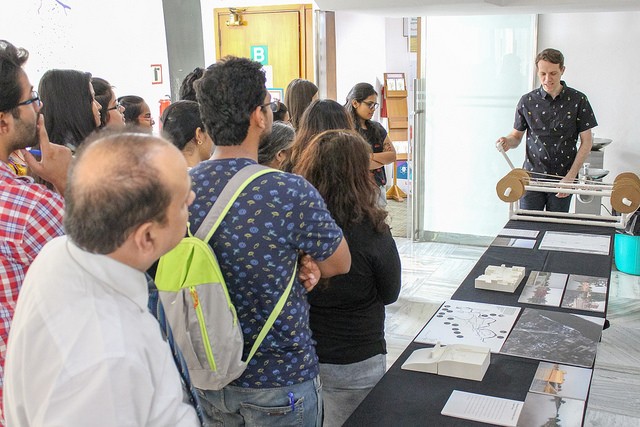The River Ganga: India’s Iconic Water Machine

The mythological, cultural and agricultural significance of the River Ganga has long captured the country’s imagination, but few realize it is also one of the most hyper-engineered landscapes of the world. Over the past 150 years, the ancient river has been transformed into India’s iconic water machine. This transformation is more than just a cartographic concern, it merits greater scrutiny.
In August, the Columbia Global Center in Mumbai organized ‘The River Ganga: India’s Iconic Water Machine,’ a 10-day exhibition by Anthony Acciavatti, Adjunct Assistant Professor, Graduate School of Architecture, Planning and Preservation, Columbia University. Combining techniques from the arts and sciences, the exhibition showcased the first systematic study and comprehensive mapping of the infrastructural transformation of the Ganga River Basin. “The exhibition educates a large number of people about the gaps in our understanding of rivers. Management of the Ganga needs to be a multi-stakeholder effort, and I am happy to be a part of this endeavor,” said Rajashree Birla, Director, Aditya Birla Group of Companies, while inaugurating the exhibition on August 18th at the Nehru Science Centre.
Acciavatti set out to map the Ganga in 2005, armed with a mobile phone and camera, for what he expected would take a year. He eventually spent more than a decade hiking, driving, and boating across the river in order to map it and to understand the growing conflicts over water for drinking, agriculture, and industry. He published his findings in a book, Ganges Water Machine: Designing New India’s Ancient River, which was awarded the 2016 John Brinckerhoff Jackson Book Prize.
The exhibition, designed to reflect the shape of a river, took visitors through a visual journey of the descent of the Ganga from the Gangotri glacier in Gaumukh. It offered glimpses into the fascinating transformation of the river bank in Allahabad – from wheat and paddy fields to festive tents during the Magh and Kumbh melas, and back to agricultural fields thereafter. The maps illustrated the rhythmic shifts of the river and its tributaries based on the cyclical shifts of the monsoon, while transects and photographs showed the penetration of technology – canals, tubewells, and barrages – and how it has been used and abused to extract water for agriculture and drinking purposes.
The Center organized the exhibition as part of its continued efforts to investigate and highlight issues related to water access and management. To this end, the exhibition was complemented by a series of public programs that delved deeper into issues of integrated water management ranging from the interplay of groundwater and surface water bodies to the impact of climatic shifts on rivers, and from the conflict between science and spirituality to the challenges policymakers have faced in dealing with such a densely populated landscape.
To introduce the next generation of professionals to newer research methodologies and contemporary global debates on water management, the Center organized numerous guided walkthroughs and expert interactions. Leading academic institutions, including the Tata Institute of Social Sciences, SVKM’s NMIMS School of Design, the Gateway School of Mumbai and Cathedral and John Connon School, participated. “Incredible work, I would have never imagined something like this was possible in my wildest dreams,” said Harsh Vora, a student from the Sir JJ College of Architecture. The objective was to reinforce the value of rigorous research and to inspire students to think beyond their taught curriculum. Many noted learning new things about the river including, for example, that it is has the world’s longest canal.
A special screening of the documentary ‘Agony of the Ganges’ was organized on August 20th, followed by a panel discussion on ‘Rivers of the Future: Evolving Approaches to Integrated Water Management’ on August 22nd. In addition to Acciavatti, the panelists included Madhav Chitale, former member, National Ganga River Basin Authority and Roshni Udyavar Yehuda, Head, Rachna Sansad Institute of Environmental Architecture. Shedding light on the magnitude of the challenge most policymakers face, Chitale noted, “Working on the Ganga entails recognizing that it has many ‘Gangas’ within it. The challenges of the upper, middle and lower Ganga Basin are all distinct in characteristics, defined by differential monsoon and land use, and solutions need to be tailored accordingly.”
On August 23rd, a webinar and livestream entitled ‘When River Becomes Machine’ was organized to probe the issues of policy around the mechanization of the Ganga further. It featured an insightful discussion between Acciavatti and Vinod Tare, Professor of Environmental Engineering and Management and Founding Head of the Centre for Ganga River Basin Management and Studies, Indian Institute of Technology Kanpur. Experts from Sir J.J. College of Architecture and the National Institute of Hydrology in Roorkee also participated remotely.
The Center plans to take this exhibition to other Indian cities in the future.